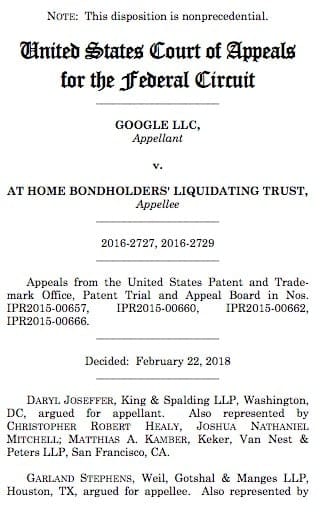
Google, LLC lost their appeal of two final written decisions of the United States Patent and Trademark Office Patent Trial and Appeal Board involving the way banner ads are cached. One of the arguments was that one of the patents did not reference blockable versus un-blockable URL requests.
At Home Bondholders’ Liquidating Trust (“At Home”) owns the ’045 and ’698 patents directed to a method of monitoring and controlling information delivered over a computer network. According to the patents, banner ads on web pages are cached, which reduces page load speed. But, caching creates problems for internet advertisers, who rely on accurate counts of how many times there banners are requested. One could stop caching requests, but that’s impractical. The ’045 and ’698 patents purport to resolve those competing objectives by adding a non-blockable banner request before checking the cache for stored banners.
Google petitioned for a series of IPRs arguing that certain claims of the ’045 and ’698 patents would have been obvious at the time their inventions were made.
At Home argued that the mere mention of requesting CGI scripts was insufficient for disclosure of a non-blockable request, because not all requests that reference a CGI script are non-blockable. Google replied that because requests for CGI scripts are non-blockable by default due to its dynamic nature, a person of ordinary skill in the art would under-stand that disclosing a request to execute a CGI script would also disclose a non-blockable request.
The Board, in their decision, determined that Angles (U.S. Patent 5,933,811) did not teach the non-blockable limitation. The Board also concluded that Google had not met its burden to prove by a preponderance of the evidence that the instituted claims are un-patentable as obvious.
Google appealed, and the court affirmed the prior decisions for the board. You can read the entire decision here.